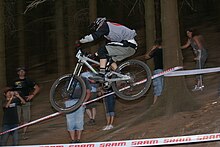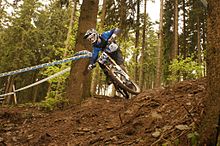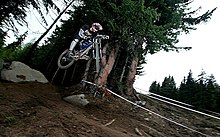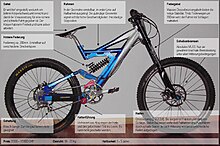Downhill
Downhill , also downhill , is a variant of various sports, especially cycling (more precisely mountain biking ). It is important to master a downhill stretch in the shortest possible time.
In English usage, downhill is synonymous with downhill skiing as a discipline in alpine skiing .
Basics
In downhill (“DH” for short, “downhill” in English) - analogous to skiing - you have to ride a closed, exclusively downhill stretch with special bicycles as quickly as possible. In the roughest terrain, peppered with natural obstacles and at speeds of over 70 km / h, the sports equipment must be under full control at all times. The difficulty is to find the fine line between maximum speed and low risk of falling. Downhill is also practiced as a competitive sport. The UCI organizes races in the Downhill Individual (DHI) discipline at Mountain Bike World Cups and Mountain Bike World Championships . The 10-time world champion Nicolas Vouilloz is considered the most successful driver .
Technology of a downhill bike
High speeds and rough terrain place special demands on the technology of downhill bikes and limit their area of use to downhill riding :
- Stability: All components are primarily designed for stability. Light weight is important, but of secondary importance. The weight of a downhill bike is around 15-25 kg.
- Suspension: In order to keep the uneven ground away from the rider and to increase riding safety, downhill bikes usually have shock absorbers on the front of the bike fork as well as on the rear wheel with a large spring deflection of around 200 mm.
- Brakes: Fully hydraulic disc brakes with a brake disc diameter of around 200 mm are predominantly used. They guarantee high braking performance in all weather conditions.
- Frame geometry: flat head angle and deep front. Rear-heavy seating position for an optimal center of gravity - downhill bikes are therefore not very suitable for going uphill. The material used is usually aluminum or carbon; rare steel, which is still often found on old bikes.
- Tires: Very large and stable tires around 26 × 2.4 ″, 27.5 × 2.4 ″ or 29 × 2.4 ″ provide more grip and stability. Different profiles and rubber compounds are used depending on the weather and the nature of the ground.
- Cockpit: wide handlebars between 680 and 800 mm, which have a rise (an increase) between 15 and 50 mm. Many drivers prefer a flat cockpit, which is why flat bars, i.e. handlebars without a rise, are used. So-called DirectMount stems are increasingly used as stems, which are screwed directly onto the upper fork crown to prevent the handlebars from twisting in the event of a fall. However, this also means that serious falls can cause damage to the fork, stem or handlebars.
- Seat zone: Stable and rather uncomfortable racing bike or cross-country saddles, which have a steep incline in the opposite direction of the rear wheel.
circuit
Theoretically, all types of gear shifts are possible on downhill mountain bikes , but some special features have become established.
With pure derailleur gears, single cranks are common; In this case, the switching options are limited to a maximum of 13 gears (as of 2020). Since 2014, special downhill cassettes with gear ratios similar to racing bikes and fewer gears (from 7) have been used, which are narrower and thus enable more stable wheels. Driving uphill is not intended with the reduced gear ratios. As derailleurs short cage rear derailleurs are used. These have a short cage in order to reduce the susceptibility to contact with foreign objects or the ground and the susceptibility of the chain to vibrations. Commercially available racing bike components are sometimes used here. By eliminating the derailleur of the multiple cranks, the chain jumps off the chainring more easily, so chain guides are necessary.
In some cases, high-quality hub gears or bottom bracket gears are installed, as well as combinations of bottom bracket gears with single chain gears.
The cable car as a means of transport

Depending on the consistency in the implementation of the above-mentioned requirements, downhill bicycles have deficits in their suitability for climbing uphill. Alternatively, the ascent can be accomplished using motorized aids such as cars or cable cars. More and more mountain areas are equipping their railways with appropriate devices for bicycles.
The driving technique
The terrain offers a wide variety of requirements: bumps, loose stones, smooth roots that run diagonally to the direction of travel, high steps, long jumps, strong impacts, solid and loose ground. The faster the journey, the more actively the driver has to react to every obstacle with appropriate and sophisticated technology.
Physical stress
A fast and safe journey requires very good physical fitness. Various forces are exerted on the driver by the sports equipment; many muscles are briefly stressed during cushioning:
- Force: The driver is subjected to high physical loads in the form of impacts and accelerations .
- Coordination, fine motor skills and the ability to react: all the rider's actions and impulses must be passed on to the sports equipment within fractions of a second and must be coordinated so that the bike can make the right movement at the right time in the right place and thus make a fast ride possible.
- Stamina: The loads mentioned above must be kept constant for a period of up to 20 minutes. This service must also be performed on repeated journeys. A decrease in strength can lead to falls.
- Speed power : When racing, you have to accelerate strongly after cornering.
- Mental fitness : Not fear, but the driver needs respect and a healthy level of self-assessment in order not to put himself in danger. Mental strength is necessary in order to master difficult sections of a route without making mistakes; A little mental insecurity can lead to a fall, as the body blocks andcan no longer performthe required fine motor movements.
- General fitness: the heartbeat can quickly reach the anaerobic threshold on descents that do not require additional pedaling . If you also pedal, the maximum heart rate is often reached. With this load, the driver still has to remain relaxed and devote himself fully to the driving technique.
In summary, quick, short reactions to external influences are required.
The protective equipment
Without protective equipment, the driver would expose himself to unnecessary dangers in the field. Thanks to protectors , small falls usually go away lightly, as they protect against minor bruises and open wounds. However, even good protective equipment cannot always prevent fractures , torn ligaments and other serious injuries, so it should not be a reason to take a higher risk.
Complete protective equipment consists of a full face or full face helmet, upper body armor, protective goggles, neck brace (neck brace), gloves, elbow and knee and shin guards.
Complete protective equipment is usually mandatory during races. Likewise in most bike parks .
The dangers and disturbances
The Swiss accident insurance «Suva» classifies downhill as an “absolute risk”, in which insurance benefits can be reduced or even withdrawn entirely. Not only the competition but also the training is associated with high risks, because "it can be assumed that the limits will be explored and risks similar to those taken in the race".
Bikers counter this by saying that unlike road racing , where other road users are a frequent cause of accidents, the biker is responsible for his own actions. The downhiller is well armored and can even cope with rough falls without a scrape, but injuries are still not uncommon. Downhill bikes are forgiving of many riding mistakes that would have made you fall with a less specialized bike. It can become dangerous if inexperienced drivers overestimate themselves or if the unforeseen occurs: material failure, an unmarked wire over the path or hikers on closed routes. The greatest risk of injury, however, is falling on the neck, as this lies directly between the helmet and the back protector and is therefore unprotected. However, there are now neck braces that protect this area. Nevertheless, downhill experts like Marcus Klausmann also consider the sport to be a dangerous extreme sport.
Disruptive environmental impacts, especially at major events, can result from erosion and road damage. Due to the increased speed, downhill mountain bikes cause wild animals a stronger surprise effect than hikers, which can lead to exhausting escape behavior.
Skateboarding

Skateboard-Downhill StandUp
Downhill is also a discipline for skateboard or longboard . Competitions are held on closed mountain roads on special downhill or speed boards.
Longboard or speedboard
A longboard (often referred to as a speedboard when “downhill”) is a long skateboard without a kicktail. This is equipped with wide axles so that the ride is more stable at higher speeds. So-called speed wobbles occur with loose axes and lower speeds . These are vibrations from steerable wheels or axles that can also be observed on shopping carts, for example.
equipment
When skateboarding downhill, a fall (depending on riding style and speed) can have fatal consequences. Leather suit, helmet and protectors are worn accordingly. The leather suit protects against abrasions, the helmet against rough blows to the head and the protectors against bruises.
Experienced riders glide around a narrow curve at relatively high speed, shifting their center of gravity inwards and putting their weight on their hands. Gloves, so-called slide gloves, serve as protection. These are often made from a motorcycle glove and a plastic kitchen board.
Downhill skateboard on the road
Since there are no official downhill routes, you have to train on busy roads. This can lead to a fine ( Switzerland ), as the longboard is classified as "fäG" (vehicle-like device). However, in some regions there are extra facilities and roads that you can use for practicing. You only have to pay a small amount for this.
Technical jargon
Since the sport comes from the United States and Canada , the terms of the technical jargon also have their roots there:
- Chicken Line - Easiest, risk-free way
- Coaster - similar to the wheelie, only not sitting in the saddle, but standing; Balance by shifting your body weight and braking
- Discbrake - see: Disc brake
- Double - see: Dirt Jump
- Drop - jumping from a higher level to a lower level
- Flat - landings on the flat ("Flat") are harder than landings on steep slopes
- Flats - flat platform pedals, taken from the BMX area for freeriding, cf. Click pedals
- Flow - stands for the feeling of the flow of movement - "Flow" describes the observable "relaxed" driving of even the most difficult sections of the route; in many cycling and extreme sports disciplines it is a sharp criterion for assessing the rider ( see also: flow )
- Fork - see: suspension fork
- Freeride - see: Freeride (mountain bike)
- Gap - engl. for gap or hole; What is meant is a paragraph between two levels that you can jump over (a hiking trail or a gorge, for example)
- hang out - jump too far and then no longer reach the landing of the jump, you jump into the so-called "flat" behind the targeted landing point
- Kicker - small ramp / launch ramp or speed ramp - larger ramp
- greygorixen - mostly looking funny, falling heavily or easily
- Manual - standing, similar to "wheelie", balance only through body movement without pedaling, also called "surfing"
- moshing - racing over a stretch of road with insufficient driving technique
- North Shore - drive along on very narrow and winding wooden board constructions
- Obstacle - generally for an "obstacle" on which various jumps can be performed
- pushing - getting speed out of a hole, a hollow or a jump through dynamic body movement
- shapen - the design of jump and landing mounds; Good shaping is important in order not to hinder the "flow"
- shake - the controlled roll-off after a fall
- shred - drive down a distance quickly to have as much fun as possible
- smashing , also moaning - uncontrollably, falling heavily
- Stone dwarfs , contact with stones or rocks that damage the bike or the rider
- Step down (sometimes also called drop ) - jump from a higher level to a lower level, mostly integrated in a single "obstacle"
- Superman (stunt) Hold your hands on the handlebars and keep your whole body loose from the bike.
- Step up - jump from a lower level to a higher one
- Steezy - term for particularly stylish maneuvers
- Table - see: Dirt Jump
- Wheel (s) - engl. for wheel (wheels)
- Wheelie - ride on the rear wheel, balance with the help of pedaling and braking
Others
The “iXS European Downhill Cup” racing series has been held in Europe every year since 2008 as the most important downhill competition in Europe. In Germany and Switzerland, the “ iXS German Downhill Cup ” and the “iXS Swiss Downhill Cup” are recognized as national racing series.
The best downhill mountain bikers include Samuel Hill , Gee , Dan and Rachel Atherton , Cédric Gracia , Greg Minnaar , Fabien Barel , Matti Lehikoinen , Nathan Rennie and Steve Peat ; Marcus Klausmann and Fabio Wibmer .
High-speed downhill on different surfaces and with standard or special bikes is to be considered an extreme sport, as it involves an enormous risk. Representatives of this variant were or are Eric Barone and Markus Stöckl . The current records are, for example, around 165 km / h (gravel / sand with series model) and 222 km / h (snow slope with special model).
Web links
- World Cycling Federation (UCI) mountain bike websites
- Directory of bike parks and mountain bike routes including map on bikeparkmap.de
- Website of the iXS Downhill Cup racing series
Individual evidence
- ↑ Presentation of a 13-speed circuit in: MTB-News
- ↑ 7-speed circuit in: MTB-News
- ↑ Chain guide in: Radtechnik
- ↑ Suva defines downhillers as high-risk athletes. In: ride.ch
- ↑ Extreme sports: Downhill - on the last groove. In: sueddeutsche.de
- ↑ Nature sports - mountain biking. Bavarian State Office for the Environment (PDF)




